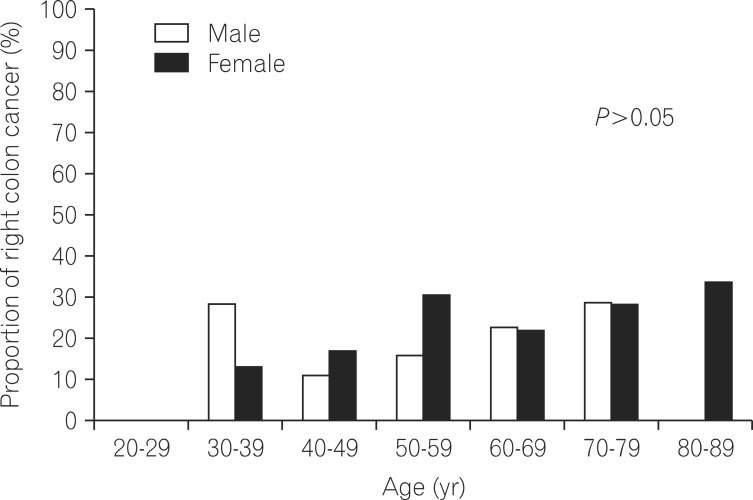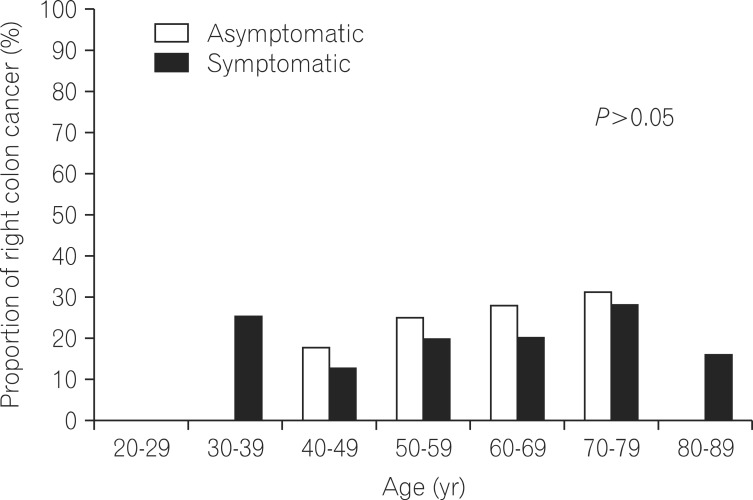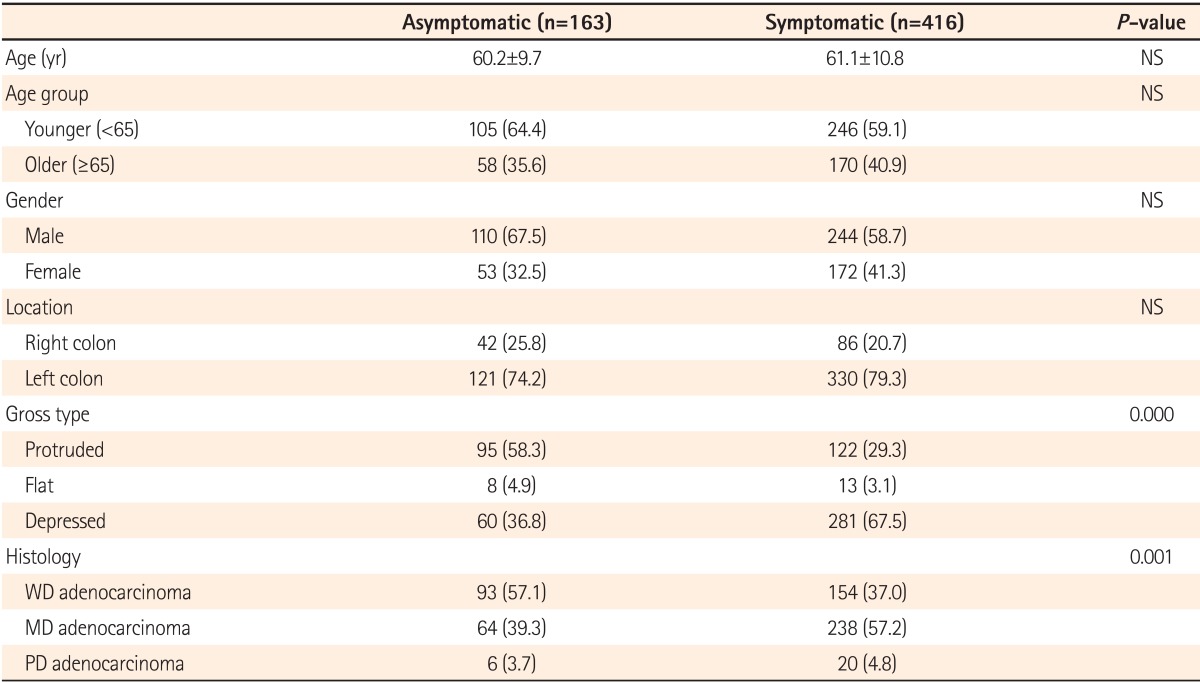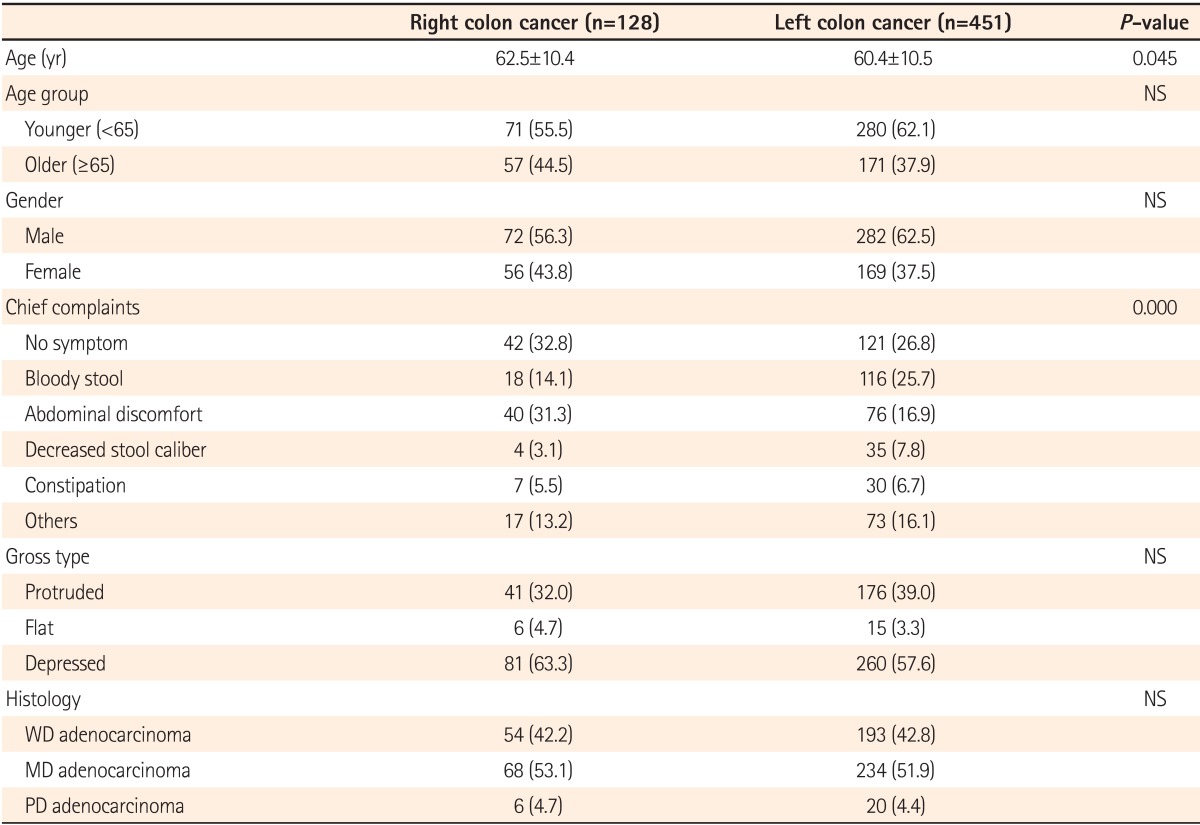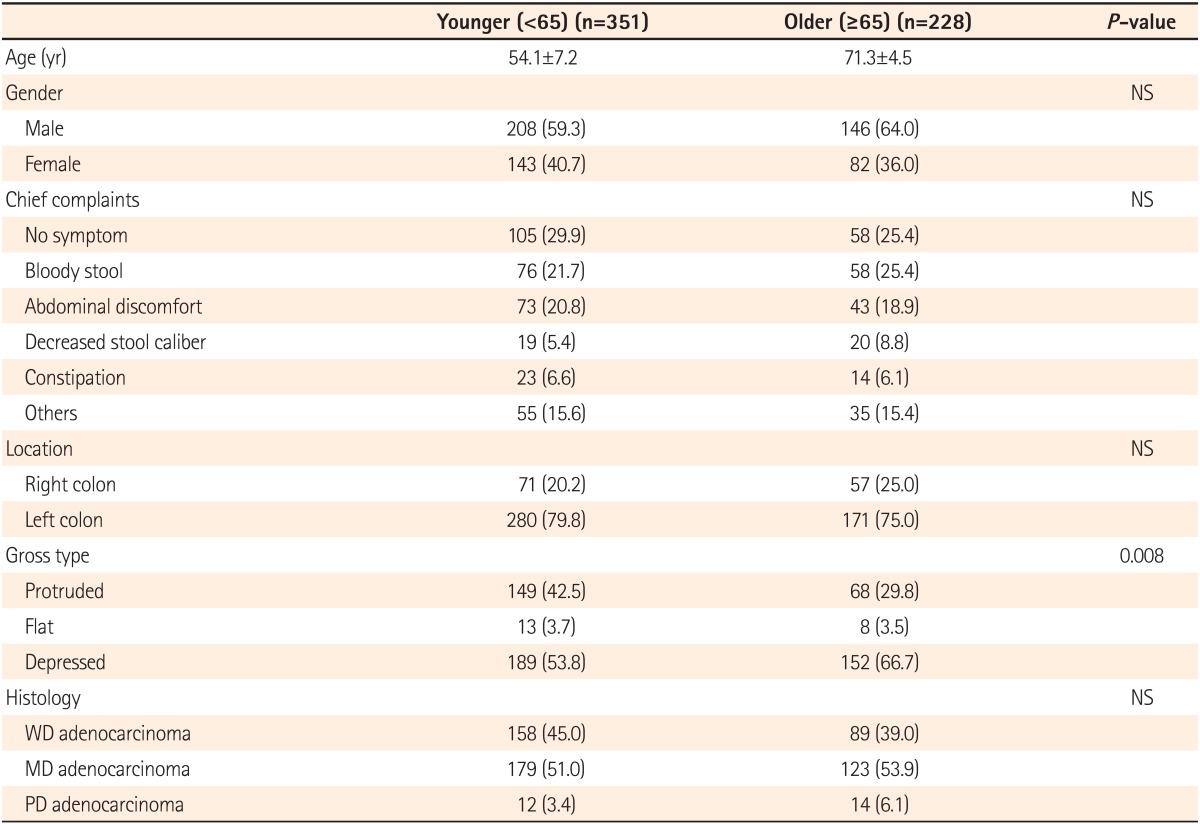 |
 |
- Search
| Intest Res > Volume 12(2); 2014 > Article |
|
Abstract
Background/Aims
The purpose of this study was to evaluate the clinicopathologic characteristics of colon cancers detected at the SOK Sokpeynhan Internal Medical Network, a nationwide system of primary health care institutions.
Methods
We analyzed 579 colon cancer patients diagnosed using colonoscopy at the SOK network from January 2011 through December 2012. Cancers from the rectum to the splenic flexure were classified as left colon cancer. Patients over 65 were classified as senior.
Results
The mean age (±SD) of subjects was 60.9±10.5 years and 61.1% were men. More than one quarter (28.2%) of patients were asymptomatic. The prevalence of left colon cancer was higher (77.9%) than that for right colon cancer. The most frequent macroscopic and histologic types were depressed (58.9%) and moderately differentiated adenocarcinoma (52.2%), respectively. Asymptomatic subjects displayed protruding or well differentiated adenocarcinoma, while symptomatic patients were more likely to display depressed or moderately differentiated adenocarcinoma (P<0.05). The mean age of the right colon cancer group was higher than that for the left colon cancer group (P<0.05). Among symptomatic patients, the most frequent symptoms were bloody stool for patients with left colon cancer and abdominal discomfort for patients with right colon cancer (P<0.05). The prevalence of depressed cancer was higher in older subjects as compared to younger subjects (P<0.05). The prevalence of right colon cancer tended to increase with age, although this difference did not achieve statistical significance (P>0.05).
Conclusions
Study results indicated an increase of colon cancer amongst younger demographics in recent years. The effectiveness of colonoscopy screening was also evident, as asymptomatic patients demonstrated frequent findings of well differentiated adenocarcinomas. Study results also suggested a need for closer examination of older patients, as right colon cancer tended to increase with age.
Colorectal cancer accounts for 9.4% of all cancers worldwide and is the fourth most common form of cancer in men and the third most common cancer in women.1 The incidence of colorectal cancer has been increasing in Korea due to changes in eating habits, decreased levels of physical activity, increased incidence of metabolic syndrome including obesity, and other factors. According to the Annual Report of the Korea Central Cancer Registry, a total of 24,986 colorectal cancer cases occurred in Korea in 2009, representing 13.0% of all incident cancer cases. Colorectal cancer is the second and third most common cancer diagnosed in Korean men and women, respectively.2
Due to the well-known population ageing phenomenon in Korea, a large number of studies have attempted to examine the clinical characteristics of colon cancer according to different age groupings. However, most of the previous studies analyzed data3,4,5,6 gathered from a single-center collected primarily from the early to mid-2000's. As most of these studies involved patients with clinical symptoms due to the nature of tertiary health care institutions, their results are not necessarily representative of the general clinical characteristics of colon cancer. In recent years, colonoscopy has been commonly performed domestically to screen asymptomatic adults. Moreover, a more complete understanding of the clinical characteristics of colon cancer is anticipated to contribute to the early detection of this increasingly common form of cancer and improvements in survival rates.
SOK Sokpeynhan Internal Medical Network is the Korean service network specialized for gastroenterology and consists of approximately 100 gastroenterologists and endoscopists in 33 primary health care institutions nationwide. These primary care centers often encounter patients with colon cancer first and are therefore at the forefront of colon cancer research and experience across the nation.
This study analyzed the endoscopic and clinical characteristics of colon cancers detected in the SOK Sokpeynhan Internal Medical Network over the last two years (January 1, 2011 to December 31, 2012).
We included patients with colon cancer first diagnosed at the SOK Sokpeynhan Internal Medical Network through a colonoscopy and biopsy from January 1, 2011 to December 31, 2012. As it was difficult to gather data pertaining to surgical results due to the nature of primary health care institutions, this study included only patients with confirmed adenocarcinoma, signet ring cell carcinoma, and squamous cell carcinoma based on biopsy results. Among the 33 primary health care institutions affiliated with the SOK network, a total of 672 cases with detected colon cancer were collected from 19 institutions. Consequently, 579 cases with accurately analyzable data from medical records were enrolled.
The research plan of this study was designed in October 2010 and a unified questionnaire was administered to participants with confirmed colon cancer on the day of visit in each institution prior to analysis by the principal investigator of each institution.
Colonoscopies were performed by 60 gastroenterologists in accordance with standard methodology. The clinical characteristics of patients diagnosed with colon cancer were examined and compared by classifying subjects according to tumor location, age, and the presence of symptoms.
Subjects were divided into two groups according to the location of their colon cancer. Cancers in the cecum, ascending colon, and transverse colon were defined as right colon cancer (RCC), while cancers in the splenic flexure, descending colon, sigmoid colon, and rectum were defined as left colon cancer (LCC). Patients were also divided into groups of younger individuals (<65 years of age) and older individuals (≥65 years of age), and into asymptomatic and symptomatic groups based on major clinical symptoms.
The endoscopic morphology of colonic lesions was categorized as either protruded, flat, or depressed types according to the pit-pattern classification scheme of Kudo et al.7 Advanced colon cancers were classified using the Borrmann's classification system, however, colon cancers in the early and later stages were not distinguishable without supporting information from the primary care center regarding the surgical procedure or mucosal resection. For this reason, Borrmann type I advanced colon cancer was defined as protruded type and Borrmann type II and III advanced colon cancers were defined as depressed type.
The histopathological findings of colon cancers were classified based on the World Health Organization (WHO) classification of tumors.8 Adenocarcinomas were subdivided into well differentiated (WD), moderately differentiated (MD), and poorly differentiated (PD) adenocarcinomas according to cell differentiation.
All statistical analyses were performed using SPSS version 10.0 (SPSS Inc., Chicago, IL, USA). Pearson's chi-square tests and Fisher's exact tests were used in the statistical analyses. P-values less than 0.05 were considered statistically significant. The correlation between age and the location of the colon cancer was evaluated using linear by linear association.
The mean age (±SD) of patients was 60.9±10.5 years and ranged from 27-85 years. The 188 subjects in their 50's accounted for the largest percentage (32.5%), and were followed by the 183 (31.6%) subjects in their 60's, the 120 subjects (20.7%) in their 70's, the 58 (10.0%) subjects in their 40's, the 15 (2.6%) subjects in their 30's, the 14 (2.4%) subjects in their 80's, and a single (0.2%) subject under 30 years of age. When subjects were divided into younger (<60) and older (≥65) age groups, 351 patients (60.6%) belonged to the younger group and, 228 patients (39.4%) belonged to the older group.
The percentage of men was greater than that of women (n=354 [61.1%] men; n=225 [38.9%] women), and the male:female ratio was 1.6:1.
Of the 579 subjects with colon cancer, "no symptom" (asymptomatic) accounted for the largest percentage (28.2%) of cases, followed by bloody stool (23.1%), abdominal discomfort (20.0%), decreased stool caliber (6.7%), constipation (6.4%), changes in bowel habits (5.0%), diarrhea (4.5%), tenesmus (2.6%), indigestion (1.9%), weight loss (1.0%), nausea and vomiting (0.3%), and abdominal mass (0.2%).
Regarding tumor location, 189 cancers (32.6%) were found in the rectum, accounting for the largest percentage of all cases, followed by 171 cases (29.5%) detected in the sigmoid colon, 67 cases (11.6%) detected in the ascending colon, 55 cases (9.5%) detected in the rectosigmoid junction, 31 cases (5.4%) detected in the descending colon, 29 cases (5.0%) detected in the transverse colon, 20 cases (3.5%) detected in the hepatic flexure, 11 cases (1.9%) detected in the cecum, 5 cases (0.9%) detected in the splenic flexure, and a single case (0.2%) detected in the ileocecal valve. When subjects were divided into two groups according to the location of their colon cancer, 451 cases (77.9%) were LCC and 128 cases (22.1%) were RCC.
Among the 579 cases, the most common gross morphology was depressed type found in 341 patients (58.9%), followed by protruded type in 217 patients (37.5%) and flat type in 21 (3.6%) patients.
According to the WHO classification of tumors, adenocarcinoma represented the largest percentage (575 cases or 99.3%) of all 579 cases, followed by 2 cases (0.3%) of signet ring cell carcinoma, a single case (0.2%) of mucinous adenocarcinoma, and a single case (0.2%) of rectal squamous cell carcinoma. According to the degree of differentiation, adenocarcinomas were divided into 247 cases (42.7%) of WD adenocarcinoma, 302 cases (52.2%) of MD adenocarcinoma, and 26 cases (4.5%) of PD adenocarcinoma.
Among the 579 cases with colon cancer, 163 patients (28.2%) were asymptomatic and 416 patients (71.8%) were symptomatic. The percentage of asymptomatic younger adults was 64.4% (105/163 cases) and the proportion of asymptomatic men was 67.5% (110/163 cases). Although higher percentages of younger adults and men were observed in the asymptomatic group, there were no statistically significant differences as compared to the symptomatic group. The proportion of RCC was 25.8% (42/163 cases) in the asymptomatic group, which was slightly higher than the 20.7% (86/416 cases) detected in the symptomatic group. However, no statistically significant differences were found. Protruded type (58.3% [95/163 cases]) and WD adenocarcinoma (57.1% [93/163 cases]) were more commonly detected in asymptomatic patients, while depressed type (67.5% [281/416 cases]) and MD adenocarcinoma (57.2% [238/416 cases]) were more frequently observed in symptomatic patients. A statistically significant difference was found between these two groups in this regard (P<0.05) (Table 1).
The mean age of subjects with RCC was 62.5 years, which was statistically significantly higher than the mean age of 60.4 years for subjects with LCC (P<0.05). In both groups, asymptomatic cases were the most common. In LCC, bloody stool was the most common symptom detected in 116 subjects (25.7%), followed by abdominal discomfort in 76 subjects (16.9%), narrow caliber stool in 35 subjects (7.8%), constipation in 30 subjects (6.7%), changes in bowel habit in 27 subjects (6.0%), diarrhea in 23 subjects (5.1%), and others. In RCC, abdominal discomfort was the most common symptom found in 40 cases (31.3%), followed by bloody stool in 18 cases (14.1%), and constipation in 7 cases (5.5%), showing statistically significant differences from LCC patients (P<0.05). No statistically significant differences were found in gross or histological findings between these two groups (Table 2).
No statistically significant differences were found in clinical characteristics between the younger and older groups with the exception of the endoscopic gross type of lesions. There were 189 depressed type (53.8%), 149 protruded type (42.5%), and 13 flat type (3.7%) in younger adults as compared to the 152 depressed type (66.7%), 68 protruded type (29.8%), and 8 flat type (3.5%) in older adults. The frequency of the depressed type was statistically significantly higher in the older subjects (P<0.05) (Table 3).
Subjects were divided into different age groups; 20's, 30's, 40's, 50's, 60's, 70's, and 80's. The distributions of patients with RCC were 0%, 20.0%, 13.8%, 21.3%, 22.4%, 28.3%, and 14.3%, respectively. The frequency of RCC increased with patient age, but did not achieve the level of statistical significance (Fig. 1). The distributions of RCC patients in males were 0%, 28.6%, 10.7%, 15.7%, 22.7%, 28.6%, and 0%, respectively and the distributions of RCC patients in females were 0%, 12.5%, 16.7%, 30.1%, 21.9%, 27.9%, and 33.3%, respectively. The frequency of RCC increased with patient age in both men and women, but did not reach the level of statistical significance (Fig. 2). The distributions of RCC patients in the asymptomatic group were 0%, 0%, 17.6%, 25.0%, 28.1%, 31.0%, and 0%, respectively and the distributions of RCC patients in the symptomatic group were 0%, 25.0%, 12.2%, 19.7%, 19.8%, 27.5%, and 15.4%, respectively. The frequency of RCC increased with patient age, but did not reach the level of statistical significance between the asymptomatic and symptomatic groups (Fig. 3).
In recent years, colonoscopy has been commonly conducted domestically for health screening purposes. However, domestic studies on the clinical characteristics of colon cancer have been insufficiently performed despite the increasing incidence of colorectal cancer in Korea. The current study examined the clinicopathologic characteristics of colon cancer first detected in the SOK Sokpeynhan Internal Medical Network, a cluster of primary care institutions located nationwide, over the last two years. According to the 2009 cancer statistics of the Korea Central Cancer Registry,2 patients in their 60's (29.7%) accounted for the largest percentage of all patients diagnosed with colon cancers in 2009. In contrast, patients in their 50's (32.5%) accounted for the highest proportion of all cases, followed by patients in their 60's (31.6%), in the current study. This outcome may be attributable to the early detection of cancers along with widespread endoscopy use, however, the possibility of an increasing incidence rate of colon cancers at an early age cannot be excluded. Therefore, colonoscopy may be crucial at younger ages (50's) to screen for colon cancers, and additional studies will be necessary to verify any effects of early screening.
The symptoms of colon cancers vary depending on the location of onset area, size, speed of cancer progression, and the presence of complications. Abdominal pain, bleeding, anemia, and weight loss are often associated with RCC depending on tumor location. Symptoms of intestinal obstruction, changes in bowel habit, bleeding, narrow caliber stool, and others are associated with LCC.9 Lee et al.4 identified abdominal pain as the most common symptom. Conversely, Lee et al.5 and Jeong et al.10 found that bloody stool was the most common sign accounting for 37.5% and 58.5% of the reports, respectively. The frequency of asymptomatic cases ranged from 2.1%-10.6% in these three previous studies. In contrast, asymptomatic cases represented the largest proportion (28.2%) of all subjects, followed by bloody stool (23.1%), and abdominal discomfort (20.0%) in the current study, showing differences as compared with other previous studies. These differences may have been attributable to the high ratio of asymptomatic patients who visited primary care centers as cancer screening examinees. In a recent study conducted by Kim et al.6 performed in a tertiary medical institution, the percentage of asymptomatic cases was the highest at 33.5%, followed by bloody stool (31.9%), changes in bowel habit (27.3%), and abdominal pain (27.0%), showing alignment with the results of the current study.
The aforementioned outcomes were anticipated results based on the increased detection of asymptomatic patients with colon cancers due to widespread screening in recent years. To examine such outcomes in further detail, asymptomatic cases were more frequently detected in both RCC and LCC. Excluding asymptomatic patients, abdominal discomfort (46.5%), bloody stool (20.9%), and constipation (8.1%) were the most commonly observed symptoms in patients with RCC, whereas bloody stool (35.2%), abdominal discomfort (23.0%), narrow caliber stool (10.6%), and constipation (9.1%) were more commonly observed in patients with LCC. All previous domestic studies4,11,12 reported abdominal pain as the most common symptom (range, 62.7%-95.5%) in patients with RCC. In contrast, Lee et al.4 and Hwang et al.11 suggested changes in bowel habit (34.1% and 87.9%, respectively) and Lee et al.12 reported abdominal pain (54.7%) as the most commonly detected symptoms, which differ from the findings of the current study.
When subjects were divided into asymptomatic and symptomatic groups, the ratios of younger adults, males, and those with RCC in the asymptomatic group were higher than those of symptomatic group, however, no statistically significant differences were found between the two groups. According to the endoscopic morphology of lesions, protruded type (53.8%) was the most common gross type in the asymptomatic group, while depressed type (67.5%) was most common in the symptomatic group. Based on histopathological classification, WD adenocarcinoma accounted for the largest percentage (57.1%) in the asymptomatic group, while MD adenocarcinoma accounted for the highest proportion (57.2%) in the symptomatic group, showing a statistically significant difference between the groups. A higher frequency of protruded type and WD adenocarcinoma in the asymptomatic group may be attributable to the higher prevalence of early onset colon cancer in the asymptomatic group. Forecasts of early onset cancer frequency were 55.2% in the asymptomatic group and 22.8% in the symptomatic group in the current study.
As none of the previous domestic studies have compared subjects according to the presence of symptoms, a comparison cannot be performed. Along with widespread colonoscopy use for colon cancer screening, the current study was able to identify opportunities to implement colonoscopy in order to treat the high frequency of protruded type colon cancer found in the asymptomatic group. Additionally, the effectiveness of colonoscopy was projected to have a more favorable prognosis in those with a high frequency of WD adenocarcinoma. However, additional studies on asymptomatic patients will be crucial in order to further our understanding of the effectiveness of early colonoscopy screening in these individuals.
As a result of the rapidly ageing population, the frequency of colon cancer was forecasted to increase in the elderly. Only a few domestic studies have been conducted on colon cancers in the elderly Korean population. In the current study, the percentage of younger adults (60.6%) was slightly higher than older adults (39.4%), and the results aligned with those of previous studies.5,6 Asymptomatic cases were the most common in both age groups in the current study, a different outcome from the study of Lee et al. where bleeding was the most common symptom in both groups. These different results may be partially associated with the popularization of colonoscopy and widespread endoscopy use for health screening.
The ratios of RCC were 20.2% and 25.0% in the younger and older groups, respectively, in the current study. In both groups, MD adenocarcinoma and depressed type were the most common, but the frequency of the depressed type was significantly higher in the older group. In the study of Lee et al.,5 the ratios of RCC were 19.3% and 21.2% in the younger and older groups, respectively. WD and PD adenocarcinomas were significantly higher in the younger group, while MD adenocarcinoma was significantly more likely in the older group. Although no statistically significant difference were found in gross type between the two groups, the depressed type was more frequently observed, differing from results of the current study. Differences between these studies may be a result of the diversity of subjects including the frequency of early cancer, research institution, and other factors. Additional studies will be necessary for more accurate analyses.
In terms of cancer sites, the ratio of RCC showed a relative increase with age,4,5,13,14 and was significantly higher in aged women in particular according to previous studies.3,15,16 In the current study, the prevalence of RCC tended to increase with age regardless of the presence of symptoms in both men and women, however, these differences did not reach the level of statistical significance. Although statistical significance varied by investigator due to differences in subjects, a higher frequency of RCC in aged individuals was common factor in many studies. Therefore, a more thorough examination on the right side of the colon may be critical during colonoscopy, especially in aged patients.
There were some limitations to this study. As the study was conducted in primary care institutions, the accurate discrimination of early and advanced colon cancers was unattainable without data regarding surgical procedures or mucosal resections. Consequently, analyses were limited to examining gross types based on endoscopic morphology. Moreover, it is unclear whether the results of the current study are representative of all primary care institutions in the country. Unlike other previous studies, the examination of the clinicopathologic characteristics of colon cancer with widespread colonoscopy use for cancer screening in the current study was meaningful in identifying the clinical characteristics of colon cancer in asymptomatic patients. A comparison between the two groups was difficult due to a relatively small sample size in the asymptomatic group. Additional investigation will be essential in further identifying the characteristics of asymptomatic colon cancer.
The increasing incidence of colon cancer is more likely to accelerate rapidly due to population ageing, changes in lifestyle habits, and other factors. For this reason, understanding the clinicopathologic characteristics of colon cancer is anticipated to contribute to improving the early detection and survival rates of colon cancer. Moreover, determining the clinical characteristics of asymptomatic patients with colon cancer is substantially important, as the detection rate of asymptomatic patients with colon cancer has increased with widespread of health screening. Additional studies will be required to further investigate colon cancer from a wide range of perspectives.
References
1. Parkin DM, Bray F, Ferlay J, Pisani P. Global cancer statistics, 2002. CA Cancer J Clin 2005;55:74-108.PMID: 15761078.


2. Cancer Statistics in 2009. Cancer incidence [homepage on the Internet]. Goyang: National Cancer Institute, 2012:cited 2012 Apr 11. Available from: http://www.cancer.go.kr/.
3. Cho YK, Pyun YJ, Sung KC, et al. A study for The changing subsite distribution of colorectal cancer with age and sex. Korean J Gastrointest Endosc 1997;17:771-777.

4. Lee HL, Han DS, Jun DW, et al. Relationship between age and site of colorectal cancer based on colonoscopic findings. Korean J Gastrointest Endosc 2004;29:181-184.
5. Lee HS, Lee S, Seo JH, et al. Characteristics of colorectal cancer in elderly patients in comparision with younger patients. Korean J Gastrointest Endosc 2007;34:76-82.
6. Kim JY, Jang ES, Park SY, et al. Distinct characteristics of colorectal cancer and frequency of right colon cancer in elderly patients of Korea. J Korean Geriatr Soc 2010;14:147-154.

7. Kudo S. Early colorectal cancer: detection of depressed types colorectal carcinomas. 1st ed. Tokyo: Igaku-Shoin, 1996.
8. In: Hamilton SR, Aaltonen LA. eds. World Health Organization Classification of Tumours. Pathology and Genetics of Tumours of the Digestive System. 1st ed. Lyon: IARC Press, 2000.
9. Sabiston DC. Essentials of surgery. 1st ed. Philadelphia: WB Saunders Co, 1987.
10. Jung SA, Yang SK, Kang GH, et al. Clinicopathologic features and indication of endoscopic treatment of early colorectal cancer. Korean J Gastroenterol 1998;32:475-483.
11. Whang IS, Park MH, Chon HJ, Lee SW, Ryu HS, Hyun JH. A clinical study on the carcinoma of the colon and rectum. Korean J Gastroenterol 1987;19:105-111.
12. Lee JH, Nah YW, Suh BJ, Chang SH, Paik IW, Lee HS. Chronological changes of colorectal cancer. Korean J Gastroenterol 1999;33:51-57.
13. O'Connell JB, Maggard MA, Liu JH, Etzioni DA, Livingston EH, Ko CY. Do young colon cancer patients have worse outcomes? World J Surg 2004;28:558-562.PMID: 15366745.


14. Cooper GS, Yuan Z, Landefeld CS, Johanson JF, Rimm AA. A national population-based study of incidence of colorectal cancer and age. Implications for screening in older Americans. Cancer 1995;75:775-781.PMID: 7828127.


15. Vobecky J, Leduc C, Devroede G. Sex differences in the changing anatomic distribution of colorectal carcinoma. Cancer 1984;54:3065-3069.PMID: 6498782.


16. Butcher D, Hassanein K, Dudgeon M, Rhodes J, Holmes FF. Female gender is a major determinant of changing subsite distribution of colorectal cancer with age. Cancer 1985;56:714-716.PMID: 4005821.







